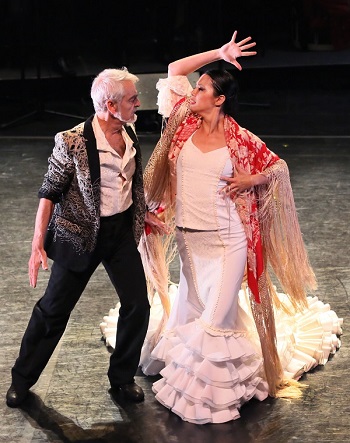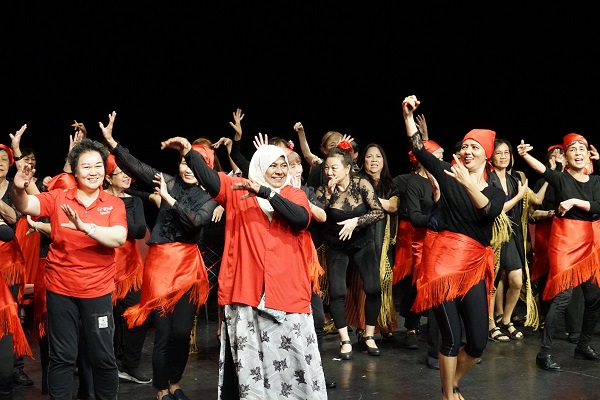Throughout my medical student life, I loved to dance but never really got around to it in any serious fashion, partly due to the rigours of studying for my medical specialist degree. Medical officer days in my time were tough too – we did calls that usually had no post-call day off, and when we returned home after two days working in the hospital, we would often crash out like a dead log. Combined with my spare time spent studying for examinations, I hardly had time to take dance classes.
My first dance steps
All that changed one day when I decided not to pursue a specialist path anymore, much to the dismay of my medical tutors at that time. Not needing to spend my free time studying, I decided to pursue a hobby. I signed up for various dance classes that included genres such as Argentinian tango, Latin ballroom and salsa. One day, I stumbled upon an article about flamenco dancing. At the time, my unworldly and ignorant self had not encountered this word before, and so I was extremely curious about it. It was described in a magazine as a highly passionate, expressive and evocative dance form from Spain, with its origins associated with gypsies. My curiosity was piqued.
I found that this dance form was very different from anything I had done before. It required a combination of arm work, postures, turns, marking steps to the music and songs, and footwork technique for rhythm. As flamenco is a live art form with the traditional trifecta of song, guitar and dance, I had to learn the different palos or dance/music forms that were different from one another, each with its own unique style, rhythm, mood and songs. Later, I also had to learn how to communicate with live musicians in a dance piece. It was definitely a steep learning curve, but the more I danced, the more intrigued I became.
The path forward was by no means easy as I had no prior dance background or training. Dancing wildly in clubs, fuelled by alcohol in my blood, certainly did not count. What drew me especially was that flamenco required you to express yourself individually, to be your own person, and that it did not conform to the usual "standards" of body shapes and types. You could also dance it well into your 50s and 60s. I saw people big and small, tall and short, old and young, all performing flamenco at a very high level. After a while, I was certainly hooked.
Flamenco Sin Fronteras
Later, I met and married a flamenco maestro and he moved to Singapore to be with me. We now have two teenage children. Flamenco was an extremely niche art form at the time and very few people knew about it. It was not easy trying to set up a flamenco school or company and undertake arts productions.
I had to learn the ropes from scratch and slowly, we began to build a flamenco community in Singapore. We decided to take the plunge and opened a non-profit arts company Flamenco Sin Fronteras in late 2011. In 2013, we started producing theatrical flamenco productions and have not looked back since. Ten years later, we are now recognised as a serious arts group in Singapore, contributing to the local arts scene, collaborating with other renowned Singaporean artistes, and crossing borders and boundaries with our art form. Some of our past productions include Misa Flamenca (a choral work with flamenco), Elements (flamenco with Chinese cultural influences), Amor Ratii (Kathak Indian dance mixed with flamenco), and The House (a flamenco dance drama). We also became part of the National Arts Council-Arts Education Programme and have introduced flamenco to mainstream schools all over Singapore.

Singapore Flamenco Festival 2016 Misa Flamenca. Photo: Andy Tan
Helping those in need
We also started doing flamenco in the community. We have been part of the Silver Arts initiative by the National Arts Council, and we have been working with low-income elderly, at-risk children from low income or single-parent families, and the Singapore Association for Mental Health. I have a great sense of pride and satisfaction when I see how flamenco can help our vulnerable communities.
Flamenco requires the coordination of arms, feet, head and body, all moving at the same time with much wrist movement that helps to loosen stiff joints. One also needs to understand rhythms and be able to express emotions of the dance – sadness, happiness, flirting, etc. It also empowers individuals, especially women, as flamenco dancers can be seen as being strong – one does not need a male partner and can dance it at any age. Many of the elderly ladies I teach would say to me: "To be able to coordinate, remember and dance my routine definitely helps to prevent dementia!"
Our group works actively with Social Health Growth, and I have been teaching flamenco to a group of Chinese-dialect-speaking matured women in low-income areas for the last three to four years. We adapted to their age with moves that are gentle on the knees and even turned some jaleo lyrics in our dance into Hokkien and Malay.
These students were initially lacking in coordination and were too shy to perform in front of the public, needing me to dance with them. Now, they have progressed to putting up mini dance dramas (they acted as Samsui women in December), co-creating parts of the performance, and can dance independently. They have their own dance social groups, meeting regularly as flamenco has become part of their "health dance".
I believe that flamenco has helped to give them purpose – something to look forward to and to bond socially with fellow dance mates. I once titled their item "Ah Ma can dance bulerias, and so can you!" Many of these ladies are aged between 60 and 70, with a few nearing 80. It certainly stimulates them physically and mentally, and I love how they enjoy themselves thoroughly each time. Laughter is certainly the best medicine.
A particularly memorable case was that of a cute grandma in her late 70s. She had fallen and sustained a vertebral compression about two years ago and was initially wheelchair-bound. She wanted so much to be back with her friends that, with absolute determination, she pushed herself a bit more each time, and is now able to climb up the stairs to the second storey for our dance classes.

La Fiesta 2022. Photo: Flamenco Sin Fronteras
Final thoughts
Due to my work in Flamenco Sin Fronteras where I perform and teach, I now practise medicine as a part-time locum – mainly as a doctor in nursing homes. I feel that my artistic work in the community adds another dimension to my work as a doctor, though I perform them in different capacities.
Looking back, I know that if I had pursued a full medical career, I might not have pursued flamenco. Growing up, I certainly never expected myself to have a career in the arts either. That would have been absurd to me at that time. The decisions you make in life certainly do throw unexpected curveballs in your path. Now that I have a family and an arts company, I continue to grow and practise my work as a GP – I certainly have no regrets.